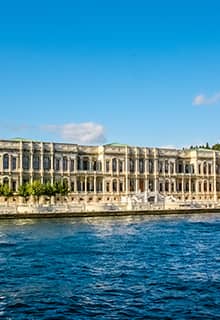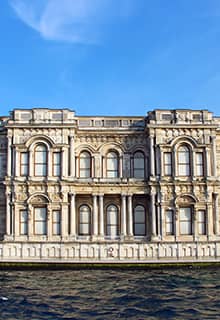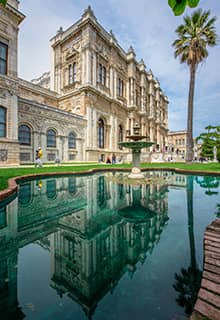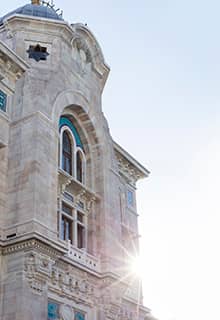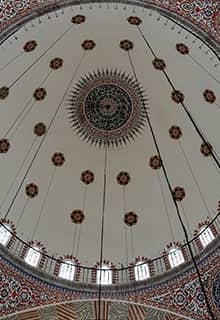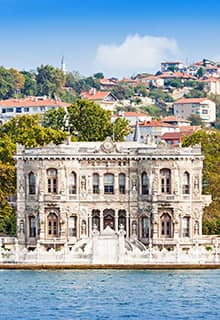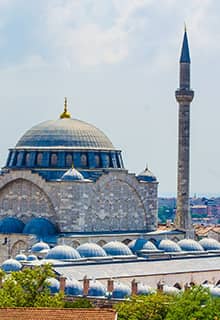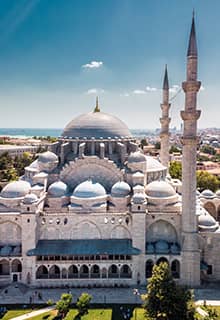

famous architects
in the history
of Turkish architecture
Mimar Sinan, The Great Imperial Architect (1490 -1588)
Born in 1490, Mimar Sinan or Koca Mimar Sinan (Grand Architect Sinan) was the chief imperial architect of the Ottoman Empire in his day. His outstanding works are known and respected all over the world. He started his famous career in the Ottoman government as a Janissary and soon after he became famous in the army as a military engineer. When he was appointed to the position as the head of the office of royal architects at the age of 50, he was ordered to build an imperial mosque, the Şehzade (Prince/Shahzade) Mosque, which, in retrospect, is considered to be one of the first masterpieces of his long career. His career included serving three Sultans, Süleyman the Magnificent, Selim II, and Murad III. His genius derived from his ability to combine his engineering expertise with his architectural vision. With the object of maximising the internal space of a building, he experimented with single and multi-dome types and, thus, thanks to his empirical approach, he achieved a geometrical purity and integral unity. Scholars list 477 structures, that were either designed or built by him, but only 196 of them has survived to the present day. Süleymaniye Mosque, Mihrimah Sultan Mosque, Kılıç Ali Paşa Complex, Haseki Hürrem Sultan Baths are some of his exceptional works. Amongst this incredible portfolio of his, Selimiye Mosque in Edirne is widely considered to be his masterpiece.
Balyan Family (18th and 19th centuries)
A well-known Ottoman Armenian Family of architects, the Balyans designed and constructed the most prominent imperial buildings such as palaces, mansions, kiosks and mosques of the 18th and 19thcenturies. For five generations they received commissions from 6 sultans, from Sultan Selim III until the last the last sultan, Abdülhamid II.
At the beginning of the 18th century. when the influence of the west accelerated within the empire, the Balyan Family became famous. They were largely responsible for the creation a Neo-Ottoman style derived from a combination of the Neo-Classical and Baroque styles. Their portfolio includes a total of seven palaces, including Dolmabahçe, four factories, one barracks, one mosque, seven churches, two hospitals, three schools, two weirs, one fountain and one mausoleum along with countless residences, Garabed Amira was the most famous architect of the Family.
Today İstanbul is full of the splendid works of the family. Among these works are mosques such as Büyük Mecidiye (Ortaköy), Küçük Mecidiye (Cirağan), Çağlayan, Teşvikiye, Hamidiye (Yıldız); the tombs of Mahmud II and Abdülmecid; Dolmabahçe, Beylerbeyi, Çirağan, Yıldız, Küçüksu, Ihlamur, Baltalimanı, Adile Sultan (Kandilli) palaces; Aynalıkavak, Izmit, Mecidiyeköy, Zincirlikuyu, Ayazağa, Kalendar royal pavilions; the Imperial College of Medicine (now Galatasaray Lycée); the Military School (Mekteb-i Harbiye); Selimiye, Davutağa, Rami, Gümüşsuyu, Maçka Barracks and Taşkışla, near Taksim; Gümüşsuyu Hospital; The Mint (Darphane); Bahçeköy Valide and Mahmud II dams; Terkos Waterworks; Bayezid Fire Tower; Tophane, Dolmabahçe and Yıldız clock towers.
Mimar Kemaleddin Bey (1870 – 1927)
Born in 1870, Ahmet Kemaleddin is also known as Mimar (Architect) Kemaleddin. He was a famous architect and restorer of both the late Ottoman Period and the of the early period of the Turkish Republic. He was one of the pioneers of the First National Architectural Movement, along with Vedat Tek, who emphasized the national identity in their designs and thus creating an authentic neo-classical Turkish style. Although Mimar Kemaleddin was deeply influenced by modern German architecture, he created a thoroughly Turkish architectural ideology and identity, which, in return, resulted in the marvellous authentic designs as can be seen at the Tayyare Apartments that are currently the building of a hotel in Historical İstanbul.
Vedat Tek (1873–1942)
Vedat Tek was a pioneering architect of the First National Architectural Movement. He was born in the late 19th century, in 1873. After graduating from Galatasaray High School, he went to France and studied at Ecole Central and Ecole des Beaux-arts in Paris. At the beginning of his career, he played an important role in the Ottoman government, first, as an appointed architect for the Ministry of Post and Telegraph and, later, as chief architect of the palaces, in which role he was the responsible for the restoration of about 20 palaces. Kastamonu Governor’s Office and İstanbul Main Post Office are among his first notable works. After the proclamation of the Republic he was called to Ankara to design and build the Grand National Assembly of Türkiye. He continued to design and build several important buildings such as Haydarpaşa and Moda Ferryboat Piers, the house of Sedat Tek and Çankaya Gazi Mansion.
Turgut Cansever (1921 - 2009)
Born in 1921, Turgut Cansever was a 20th century Turkish architect and city planner. He won the Aha Khan Award for Architecture three times. He studied architecture in İstanbul State Academy of Fine Arts, then he became the assistant of Sedad Hakkı Eldem. He based his conceptual approach on regional expressions. His best-known works include the Anatolian Club Hotel in Büyükada İstanbul (1951-1956) and the Demir Holiday Village in Bodrum (1971).
Seyfi Arkan (1903 – 1966)
Seyfi Arkan, who was born in 1903 in İstanbul, was an early Turkish Republic era modernist architect. After successful years in the İstanbul Fine Arts Academy as a student, he went to Berlin on a scholarship, where he studied with Prof. Hans Poelzig, who influenced and shaped his both understanding and style. Being invited by Atatürk to design and build the Çankaya Presidential Residence made him one of the most influential architects of the time. Although he was contemporaneous with the First National Architectural Movement, his style differed from others. Unlike Vedat Tek or Mimar Kemalleddin he did not conceptualize his design upon national identity, instead he focused on universal architectural principals.
Sedad Hakkı Eldem (1908 – 1988)
Sedat Hakkı Eldem, a pioneer architect of Turkish modernization, was born in 1908. A son of a diplomat, Eldem spent his childhood and youth in Europe, where he was educated in French in primary school and later in German in high school. Upon his return to Türkiye, he enrolled into the Academy of Fine Arts, where he found an opportunity to study with Vedat Tek and Guilo Mongeri. After his graduation he went to Europe on a scholarship. There he visited many cities and worked with Perret and Poelzig. The education that he received from both Turkish and European scholars played an important role in his architectural style. Although his early works were influenced by various European styles, from art-deco, international to Le Corbusier, he shifted his focus to Ottoman vernacular houses in his later years. Because his style frequently changed over the years, there is no one single conceptualization that characterizes Eldem. Amongst his famous works can be include: the Thermal Hotel in Yalova, Ağaoğlu House, İstanbul University Science Faculty, and the Florya Facilities in İstanbul.
19th Century Architects of İstanbul: Mongeri, Allaury, D’Aranco
The effects of westernization on the Ottoman Empire in general commenced with the Tanzimat Reforms (1839 - 1876). The movement included the modernisation of İstanbul by emulating the pre-eminent architectural style of the Europe, namely Neo-Classicism. The style was first introduced by European architects and later Ottoman architects from the Christian minorities were recruited. British architect W.J. Smith, who was commissioned to build the British Embassy and Swiss architect Gaspare T. Fossati, who was commissioned to build the Russian embassy were the first among many. In the reign of Abdülhamid II, many architects were invited or sent to İstanbul either to build or to study the history of Ottoman architecture, such as Valluary and Jachmund. Their studies resulted with in a synthesis of Neo-Classical and Ottoman features. Vallaury’s famous buildings include the School of Fine Arts (1882) and the Imperial Archeologıcal Museum. Raimondo d'Aronco, on the other hand, brought Art-Nouveau features to İstanbul, his works include such buildings as the Yıldız Palace Pavilions and the Karaköy Mosque.

